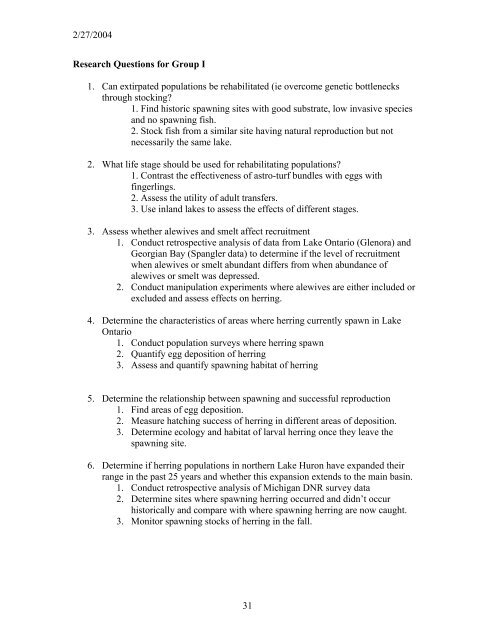Status and assessment, research, and restoration needs for lake ...
Status and assessment, research, and restoration needs for lake ...
Status and assessment, research, and restoration needs for lake ...
You also want an ePaper? Increase the reach of your titles
YUMPU automatically turns print PDFs into web optimized ePapers that Google loves.
2/27/2004<br />
Research Questions <strong>for</strong> Group I<br />
1. Can extirpated populations be rehabilitated (ie overcome genetic bottlenecks<br />
through stocking?<br />
1. Find historic spawning sites with good substrate, low invasive species<br />
<strong>and</strong> no spawning fish.<br />
2. Stock fish from a similar site having natural reproduction but not<br />
necessarily the same <strong>lake</strong>.<br />
2. What life stage should be used <strong>for</strong> rehabilitating populations?<br />
1. Contrast the effectiveness of astro-turf bundles with eggs with<br />
fingerlings.<br />
2. Assess the utility of adult transfers.<br />
3. Use inl<strong>and</strong> <strong>lake</strong>s to assess the effects of different stages.<br />
3. Assess whether alewives <strong>and</strong> smelt affect recruitment<br />
1. Conduct retrospective analysis of data from Lake Ontario (Glenora) <strong>and</strong><br />
Georgian Bay (Spangler data) to determine if the level of recruitment<br />
when alewives or smelt abundant differs from when abundance of<br />
alewives or smelt was depressed.<br />
2. Conduct manipulation experiments where alewives are either included or<br />
excluded <strong>and</strong> assess effects on herring.<br />
4. Determine the characteristics of areas where herring currently spawn in Lake<br />
Ontario<br />
1. Conduct population surveys where herring spawn<br />
2. Quantify egg deposition of herring<br />
3. Assess <strong>and</strong> quantify spawning habitat of herring<br />
5. Determine the relationship between spawning <strong>and</strong> successful reproduction<br />
1. Find areas of egg deposition.<br />
2. Measure hatching success of herring in different areas of deposition.<br />
3. Determine ecology <strong>and</strong> habitat of larval herring once they leave the<br />
spawning site.<br />
6. Determine if herring populations in northern Lake Huron have exp<strong>and</strong>ed their<br />
range in the past 25 years <strong>and</strong> whether this expansion extends to the main basin.<br />
1. Conduct retrospective analysis of Michigan DNR survey data<br />
2. Determine sites where spawning herring occurred <strong>and</strong> didn’t occur<br />
historically <strong>and</strong> compare with where spawning herring are now caught.<br />
3. Monitor spawning stocks of herring in the fall.<br />
31
















